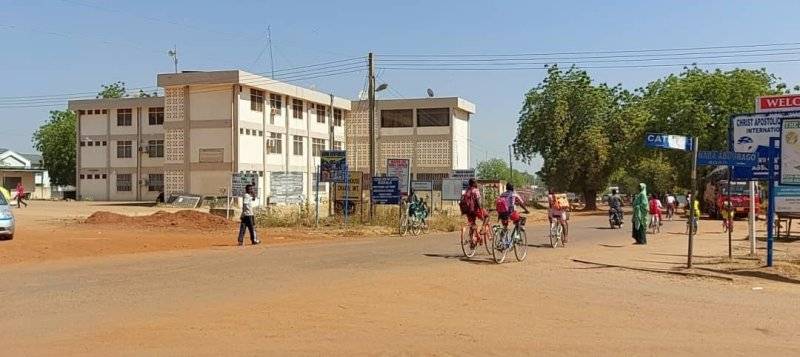Case one of the Claimants
Abugurago Azoka, also known as Abugurago Kusasi, testified in court that he resides in Bawku and owns property there.
He is a Tindana and a fetish priest.
Tindana refers to a landowner who worships a local fetish.
He produced a letter from Mr. Ian F. Baillie, the then-Government Agent stationed at Bawku, dated March 18, 1954, addressed to him.
The document is a declaration of certificate to everyone who it may concern, stating that Abugurago is the Tindana or proprietor of the Region of Bawku, currently forming the Government Area, and granting him the right to pick the fruits from Dawa-dawa trees in the area.
Abugurago claims that his grandfather Amalsum Zelbio was a Tindana, a farmer, and the Chief of Bawku before the arrival of the Europeans and the Mamprusis' conquest of the Bawku Skin.
The Mamprusis accompanied the Whiteman and were able to establish themselves in Kusasis-land thanks to the Whiteman's influence and authority.
The Mamprusis had come into touch with the Whiteman at the time and were familiar with him: the Mamprusis served as the Whiteman's cooks and servants, as well as his translator and policeman.
The Mamprusis were more informed than the normal Kusasi man, and they appealed to the Whiteman more than the Kusasi man.
The Kusasis were not well organized at the time, and they were unable to withstand the Mamprusis' benign invasion, which was backed by the Whiteman.
As a result, Bawku's skin was taken from his grandfathers and delivered to the wise Mamprusis.
He claimed, among other things, that his grandfathers held the land at Bawku and that his father Azoka had succeeded them.
The Mamprusis have no territory in the Kusasi Area and are therefore unable to be chiefs.
Only a Tindana can be chief, according to Kusasi tradition.
Because the Mamprusis are not Tindana, they are not acknowledged as chiefs by custom.
He named Amalsum Zelbio, Agua Daa, and Abadu as three of the Kusasi chiefs who governed Bawku before the Mamprusi arrived, and claimed that the Mamprusis grabbed the skin during Abadu's reign.
Abugurago provided proof of his election and installation as Bawku-naba and the Kusasi Area's Head Chief.
He claims to be a descendant of the old rulers of Bawku before to the Mamprusis invasion.
He asserts that according to custom, canton chiefs are appointed by the Bawku-Naba in consultation with the Elders and Counsellors of the specific canton, and that he, as Bawku-Naba, has lately appointed several canton chiefs in accordance with custom.
There was evidence that Abugurago is overwhelmingly supported by the Kusasis.
It should be emphasized that these canton chiefs were established to replace existing canton chiefs who refused to accept the Kusasis' course of action, either because they are Mamprusis or because they are afraid of the Kusasis' displeasure.
In reality, all chiefs who are not chosen by the Kusasis but are appointed by the Mamprusis to control the Kusasis are detested by the Kusasis at the moment, and their situation will stay fragile unless they alter their minds and support the Kusasis in their claim.
In cross-examination, Abugurago asserted that the British imposed the Mamprusi regime on the Kusasis.
This is a remark that may or may not be accurate, and more will be said about it later in this article.
He claims that the Kusa-Naba and other Kusasi region leaders were not nominated by the Nayiri to rule the Kusasis.
On the other hand, he stated that those chiefs were elected by their own people, but after they were installed, they were required to go to the Nayiri to perform certain religious rites that they believed would increase their power as rulers over their people and serve as a blessing to them during their tenure as chiefs.
Abugurago went on to say that about 1932, at the recommendation of the Central Government, it was decided that all the Canton heads of the Kusasi area that the Bakwku-naba be acknowledged as the leader of the entire territory, despite the fact that they were all equal in rank up until then.
As a result, the Bawku-naba rose to the top of the food chain as of that year.
He stated that the arrangement was made only for administrative convenience since it was thought to be conducive to good administration to administer activities from a single location, and Bawku is in a central location.
In truth, Bawku had been successfully employed as an administrative center up to that point.
The claimant stated that the Kusasis and Mamprusis have quite different methods for selecting a chief.
According to him, the Kusasis choose their chiefs via free voting, but the Mamprusis choose their leaders under coercion.
The Kusasis elect their chiefs, whilst the Mamprusis appoint theirs.
Under cross-examination, Abugurago continued to distinguish the various Kusasi practices from those of the Mamprusis.
According to him, the Kusasis pay 4 or 5 cows and other items for their brides, whilst the Mamprusis pay little more than 100 kola nuts.
According to the witness, the Mamprusis have never conquered the Kusasis, but they treat them as slaves.
Tolls and tributes are paid to the Mamprusis by the Kusasis.
The Kusasis are compelled to work on the Mamprusis' farms for no pay.
The Mamprusis kidnap the Kusasi ladies and force their husbands to pay exorbitant fees to reclaim their spouses.
He finished by declaring that the Kusasis have lost faith in the Mamprusi rulers and would never recognize them as such.
For the previous 150 years, the Mamprusi authority in Kusasi has provided no benefits to the Kusasis.
On the other side, they have suffered greatly as a result of the Mamprusis' persecution.
He argued with the government to allow complete succession from the Nayiri and Mamprusi states.
Abugurago summoned six witnesses and produced eighteen pieces of Memoranda from various divisions and organizations in the Kusasi Area in support of his argument.
The petition was signed by 16 canton leaders of Kusasi and Tindanas, i.e. landowners and ex-unions servicemen's from Kusasi's numerous divisions.
Some of the petitions were submitted by people from various professions and callings.
School teachers, influential farmers, and livestock owners also contributed to the majority of petitions presented to the Committee.
These petitions originated in the following regions and towns:
Teshie, Lambeiri, Pusiga , Sapelliga Kpatiga Garu, Binduri, Toende, Bugri, Kulukungu, Bawku, Binduri, Toende, Kugri, Binaba, and Tempane
Kusasi Youth Movement and Kusasi Veterans of the Two World Wars also presented memoranda.
Widi, Tanga, Kuka, and Gabiri chiefs also filed petitions.
The contents of all petitions presented can be summarized as follows:
1. That the Mamprusi gained their Chieftaincy about a century and a half ago beneath the strong wings of the Whiteman.
2. Their rule has been characterized by violence and tyranny.
3. That the Kusasis were considered slaves and unfit to be leaders and chiefs of their own people.
4. As the Kusasis believe in free election of their chiefs, whilst the Mamprusis believe in appointing chiefs to dominate the Kusasis in the same way that Military Governors do.
5. Abugurago is a direct descendent of the occupants of the Bawku Skin before to the Mamprusis' conquest and hence a lawful successor.
6. That Abugurago was traditionally elected by the Kusasi and enskinned in accordance with Kusasi custom.
7. That they approve the appointment of Abugurago Azoka as Chief of the Kusasis and Head of the Kusasi Area, with his capital in Bawku.
So far, this is the evidence presented by the Claimant and his supporters.


